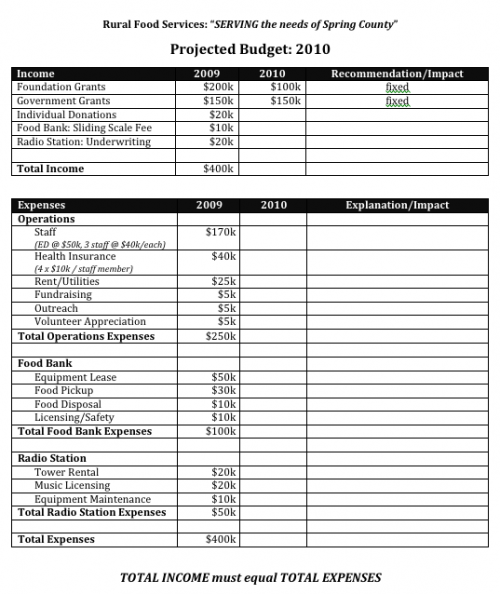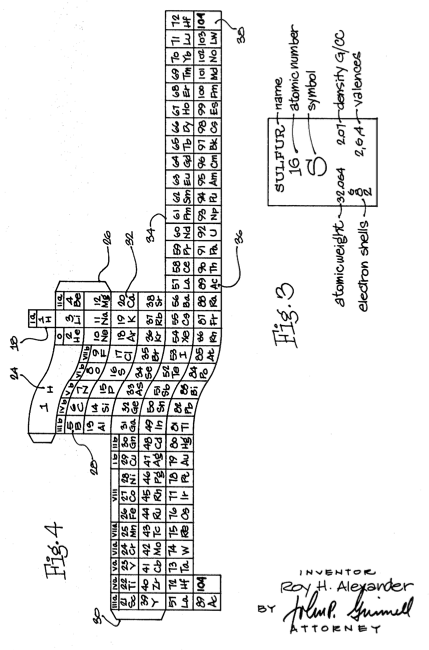While cleaning up some files, I came across this awesome scenario I wrote for our AmeriCorps*VISTA orientation last summer. I wrote it to give our new service members an idea of what it’s like to enter a small community nonprofit organization in contemporary times: under-staffed, under-resourced, broadly missioned, lacking in a comprehensive strategic plan. Most importantly, the nonprofit in this scenario lacks a well-prepared board… which is the role you play in this scenario.
I pasted the text of the scenario below, though you can download the whole thing along with the budget worksheet in a word document(.doc).
Nonprofit Board of Directors Roleplay:
**Rural Food Services **
Mission: “SERVING the needs of Spring County”
Summary:
You and your table make up the Board of Directors of a small nonprofit organization: a rural food-bank that also houses a community radio station. As the Board of Directors, you are responsible for setting overall strategy: balancing the health of the organization with the needs of the community. Every year you create an Annual Budget that provides the Executive Director with the expected income and expenses she is to manage. Unfortunately, you were just informed by your primary funder, a Private Foundation, that due to the current economic climate, all funding will be cut by 50%.
Using the following information about the organization and the community—and your own experiences and imagination—together design an Annual Budget that balances expenses with the newly reduced income. There is no “right” answer.
You have been provided with a Budget Worksheet to help you understand the current expenses and plan your cuts. Do not sweat the math so much as what your overall cost-cutting strategy is.
Be creative, but remember that this is a very common scenario that nonprofit organizations find themselves in.
At the end of this activity, your group will be asked to briefly share your budget with the room. While you do not need to go line by line, you should summarize your overall strategy for the budget, where you had to make major cuts, and the impact you expect those cuts to have upon the organization, its services and the community.
Background:
Your organization, Rural Food Services is the only Food Bank in rural Spring County. Covering 1,200 square-miles, Spring County has a population of 40,000 , an average age of 42, and a median income of $22,500. Light commercial (call centers) and light manufacturing (automotive and industrial parts) are the primary employers. And a WalMart Supercenter.
Rural Food Services was founded in the early 1980s to provide free and reduced-cost food and staples to rural Spring County. It is the only Food Bank in Spring County. 20% of residents (8,000 people) in the county receive aid from the Food Bank each year. The food itself is donated from distributors and the government, but Rural Food Services must pickup and store the food, dispose of rotten or expired food, and comply with licensing and inspection requirements.
In the year 2000, the organization applied for and received a low-power, non-commercial radio license. Since then, KSRV has been broadcasting local news, disaster alerts and community-produced stories from a small studio in a former storage room. KSRV is the only non-commercial radio station serving Spring County, and the only radio station that consistently covers local issues. All programming is created locally by volunteers, but Rural Food Services must pay for music licensing, antenna-tower rental and equipment maintenance.
Rural Food Services depends upon volunteers for nearly all of its operations. In addition to the Executive Director, the staff only includes a Finance/Operations Manager, a Grants/Fundraising Manager, and a Volunteer Manager.
**Current Circumstances: **You have just been informed that your primary funder, the Pierpont Memorial Trust, has decided to reduce all grants by 50% because of the current economic climate. Though your organization receives a mixture of private and government grants, individual donations and earned income, this news will severely impact your organization in the coming year. Tough decisions have to be made about how to cut costs with the knowledge that the need for your organization’s services has not lessened (they have most likely grown). The questions you must tackle include:
-
What do you think the organization’s priorities are? Immediate and long-term
-
What values do you think the organization should protect? Internally and externally.
-
What sacrifices are you willing to make to get the organization through the year?
In addition to cutting expenses, Rural Food Services has two “Earned Income” strategies for creating income based on their services, though each has its own drawbacks and implications.
- Sliding Scale Fee charged to individuals using the Food Bank depending on their ability to pay. Increasing this income increases the amount charged to Rural Food Services’s clients.
- Underwriting (advertising) for the Radio Station from local and national businesses. Increasing this income will reduce the local/independent focus of the station’s community-led programming.
Lastly, income from Individual Donations (“Individual Giving”) has been left open. While the current economic climate forecasts a decrease in individual giving, you could recommend the implementation of aggressive individual fundraising (especially from “Major Donors”); though such a strategy would require significant inputs of staff time and resources.
The Budget Making Process:
As the Board of Directors, you have control over how much money is allocated for specific expenses (“line items”) in the budget. For example, “staffing” or “rent”. You must take into account the impact of that reduction upon the activities that money is used for—though ultimately it is the role of the Executive Director (not yours) to cut costs within a particular line item. For example, you can decide to cut staffing costs by $20,000, but it is the Executive Director’s role to decide whether that becomes an across the board pay-cut or the elimination of a position. You still must take into account the impact such a cut will have though and make a recommendation for what that cut will look like.
Examples:
Reduce Staffing by $20,000 - The Volunteer Manager position could be reduced to half-time. Volunteers themselves could take over some responsibilities.
Reduce Equipment Maintenance budget by $5,000 - Try to stretch things out. Seek equipment donations if necessary.
Stop providing Health Insurance - Staff can apply for individual coverage (a de facto pay-cut)
Budget Worksheet: this can be downloaded in the attached Word Document.




